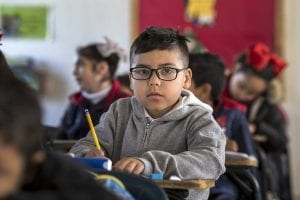Over the past few years, the number of English language learners (ELLs) has grown throughout the United States. Areas, where non-English speakers had historically made up only a small percentage of the population, have had a sudden increase in ELLs who require specialized classes.

Unfortunately, students who live in cities where school systems are unprepared and lack the resources necessary to support them are at an enormous disadvantage.
In Indiana alone, the foreign-born population is rapidly increasing, and the number of ELLs enrolled in public and private schools is, in turn, rising as well.
According to current statistics, there are 67,500 students who are considered English learners, an increase from 49,654 in 2010, as shared by the Indiana Youth Institute. This growth of ELLs in Indiana classrooms has led to high demand for more resources, including ESL teachers, bilingual assistants, English language classes, and learning materials.
It’s often assumed that a student’s language education can end once social proficiency in the target language is achieved. The ideal image is that of foreign-born students who can comfortably and effectively socialize in their target languages.
Although this achievement is astounding and worthy of praise in its own right, it leads teachers to believe that their ELLs are academically proficient in English as well; however, that’s often far from accurate.
Although the timeline for learning a second language differs depending on a number of variables – age, exposure to the target language, first language – social proficiency always develops before academic proficiency.
So, what does social proficiency mean?
Social proficiency refers to when students are able to fluently communicate in daily social situations.
It indicates that they’re able to chat with their friends on the bus and in the hallways, decide what games to play during recess, and have informal conversations with their teachers. It takes 1-2 years to achieve this level of proficiency in another language, but it doesn’t indicate academic proficiency.
What does academic proficiency mean?
Academic proficiency is the ability to fluently read, write about, and discuss academic content. This is the type of language found in textbooks, assessments, essays, and class presentations.
Although academic language is used in every grade, the frequency and complexity increase every year. Students are not only expected to clearly get their point across but to do so using complex vocabulary and grammar structures.
Academic proficiency in a new language is much more difficult to achieve than social proficiency, and it can take students anywhere from 5-7 years to achieve it.
How are they different and why is it important to know what they mean?
A significant problem emerges from a lack of understanding of the differences between these two levels of language proficiency. More often than not, when teachers see their ELLs fluently speaking English with peers in the classroom, assumptions are made that the students have mastered English and no longer require any sort of instructional accommodations.

However, this can be a dangerous assumption, as it can decrease students’ access to specialized English language instruction far too early, eliminate important language learning resources, and lead to unjust academic expectations. This, in turn, can cause students to underperform academically, receive low grades, and constantly struggle to catch up.
To avoid creating more stress for ELLs than they already have to endure, it’s crucial that teachers understand the timeline for developing a second language.
They must provide their ELLs with the necessary language and academic supports throughout this period of development, including English grammar activities, bilingual books to improve vocabulary, and assessments that accurately measure academic language proficiency.
With these tools in place, ELLs are given a fair shot at achieving academic success.



